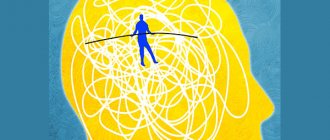Schizophrenia, although known for a long time, occurs frequently and is studied by specialists in many countries around the world, is considered one of the most mysterious mental illnesses.
As a rule, it debuts in people aged 15–25 years, very rarely after 50 years, and increases gradually. Schizophrenia is characterized by illogical thinking, perception, strange behavior, speech, and hallucinations. Symptoms of the disorder:
- pretentious nonsense - a person thinks that he is in contact with aliens, otherworldly forces, etc.;
- statements that someone directs actions, endangers, puts in or takes away thoughts;
- voices in my head;
- emotions are poor, inadequate;
- loss of desires, interest in life;
- speech disorder;
- significant deterioration in performance;
- loss of will;
- inability to concentrate;
- indifference, etc.
Catatonia (alternating stupor and excitement), stream of thoughts, apathy, and self-absorption may also occur.
Causes of mental illness
The exact cause of schizophrenia has not yet been identified. It is believed that this is a multifactorial disease that develops under the influence of a number of provoking and predisposing factors:
- Burdened heredity. If you have close relatives with schizophrenia, the risk of developing it in your offspring increases by about 20 times.
- Unfavorable social conditions such as poverty and family instability.
- Bad habits. Smoking, drug addiction, substance abuse and alcoholism do not so much cause the disease as accompany schizophrenia, complicating its course.
- Complicated pregnancy (prematurity, intrauterine hypoxia or infections).
- Emotional turmoil, especially in childhood. It has been proven that people who have experienced physical or sexual violence are more likely to develop schizophrenia.
- Anomalies in the development of central nervous system structures. Autopsies of dead patients showed that most of them had dilation of the cerebral ventricles, a decrease in the volume of the frontal lobe, and organic changes in the temporal gyri and hippocampus.
There are other theories of the development of schizophrenia that are not so popular and widespread.
What drugs are used abroad to treat schizophrenia?
The main group of medications for the treatment of schizophrenia are antipsychotic drugs (typical and atypical), their long-term use significantly reduces the risk of relapse. However, the therapeutic effect of antipsychotics is limited - they help improve positive (productive) symptoms, but are ineffective against cognitive dysfunction and negative symptoms.
The choice of drug is made by the attending physician with a careful assessment of risks, benefits and individual factors. Overall, 50% of patients respond positively to antisychotic therapy, 30% have a partial response, and 20% are resistant to therapy. In this case, drugs from an additional group, for example, Clozapine, can be used, but they have serious side effects that must be taken into account.
Antipsychotics can also have side effects, but they are statistically less common. Typical antipsychotic drugs can cause extrapyramidal disorders, while atypical ones can cause metabolic syndrome, weight gain, and diabetes.
For those patients who, for one reason or another, cannot or refuse to take medications, depot medications that provide long-term action are indicated. They are particularly effective when combined with psychosocial interventions.
Stages
The disease goes through several stages in its development, each of which is characterized by certain typical manifestations.
- Primordial. During this period, a person’s personal qualities and behavior change. The patient becomes distrustful and overly suspicious.
- Prodromal. The patient withdraws into himself, limits himself as much as possible from others, and stops communicating even with the closest people. At this stage, a person often loses his job due to his absent-mindedness, irresponsibility and lack of concentration.
- First mental episode. During this period, the patient is susceptible to obsessions and delusions, and may see hallucinations.
- Remission. This time period can vary in length from a couple of weeks to several years.
After the completion of the first cycle, a periodic change of the 3rd and 4th stages begins. Gradually, the duration of remissions decreases, and exacerbations become longer and more severe.
Innovative approaches to the treatment of schizophrenia in Israel
Psychiatry in Israel has a high level of development, as it has always been focused on the latest discoveries in this field. Due to the fact that the country is a world religious center, the number of mentally ill people here is much higher than average - they come here from all over the world. It is a proven fact that religiosity is closely related to mental illness. Therefore, Israeli psychiatrists, in addition to high qualifications and advanced treatment methods, also have enormous clinical experience.
Treatment of schizophrenia in Israel is carried out using new generation medications in combination with the most effective non-drug methods. These include primarily cognitive behavioral therapy, family therapy, and assertive conjoint therapy.
Attention is paid to maintaining the patient’s social skills and physical health - in parallel with the treatment of schizophrenia itself, therapy for concomitant diseases, correction of excess weight, etc. is carried out.
The experience of Israeli specialists shows that including the family in the treatment and rehabilitation process, in the form of family therapy and/or teaching the family how to properly interact with the patient, significantly reduces the risk of relapse and allows one to avoid hospitalization.
Innovative, experimental techniques are also used - art therapy, animal therapy, drama therapy, color therapy, etc. Acting as a supplement to the main treatment, they can increase its effectiveness.
Signs of schizophrenia
The development of vivid and characteristic clinical manifestations of schizophrenia is preceded by a premorbid period, which can last several years. During this time interval, loved ones note that the person is behaving somehow differently, has become more aggressive, withdrawn and distrustful.
The height of the disease is characterized by the development of two types of symptoms.
Positive symptoms
- Hallucinations. They can be auditory, when the patient hears voices that control his behavior, threaten him, order him to perform this or that action. Visual hallucinations are also possible, but are extremely rare.
- Rave. This symptom is characterized by the patient’s belief that evil spirits or alien beings are influencing him using magic, hypnosis, or any technical devices that do not exist in reality. Delusions of jealousy (confidence of betrayal), persecution (the patient thinks that he is being watched), self-flagellation (the patient is to blame for all earthly troubles), grandeur (a person may introduce himself as the ruler of the world), dysmorphophobia (confidence in his own external ugliness) may also occur.
- Obsessions and movements.
- Reasoning and lengthy reasoning. Patients are unable to concentrate on one topic, constantly jump from one to another, and often lose the thread of the story.
Negative symptoms
- Emotional disorders and social isolation. Schizophrenics immerse themselves in themselves and completely isolate themselves from others.
- Drift is the inability to make one's own decisions. Patients copy the behavior of others.
- Hypobulia. Patients' needs are reduced, they don't care what they eat, they refuse to take a shower, and their libido disappears.
Modern methods of treating schizophrenia in men and women
Treatment of schizophrenia abroad is carried out in two directions - medication (pharmacotherapy) and non-drug (psychocorrection). Long-term observations have made it possible to establish that taking pharmacological drugs provides a positive result in 65% of cases, psychotherapy (i.e. treatment of schizophrenia without drugs) - in 45%, and the most successful is combination or complex therapy (pharmacotherapy + psychotherapy) - success is achieved achieve in 85% of cases.
In addition, psychological and social support is included in the treatment of schizophrenia abroad. There are special support services, social and medical assistance centers, where the patient receives comprehensive assistance, ranging from psychological counseling to employment.
There is evidence that confirms the beneficial effect of physical therapy on the course of the disease, so it is often included in a complex of therapeutic measures (the same as in the treatment of addiction).
It is this approach that is currently practiced by foreign psychiatrists; this is somewhat different from the treatment of schizophrenia in Russia, when pharmacotherapy alone is used mainly.
Schizophrenia in men and women differs in the average time of manifestation - in men it often debuts before the age of 20, in women - after 20. However, this difference is rather statistical, and otherwise the disease in both sexes proceeds similarly, and the approach to its treatment is practically no different.
Basically, therapy is carried out on an outpatient basis - the patient visits a doctor who, if necessary, adjusts drug therapy, and then schizophrenia is treated at home. At the same time, the patient visits a psycho-social assistance center, or, if for one reason or another he cannot do this, he is visited by mental health service staff.
What is the psychiatric approach to treating schizophrenia in Moscow
Modern Russian psychiatry, unfortunately, remains the heir of Soviet psychiatry, which is at least significantly outdated. In the treatment of schizophrenia, as well as in the treatment of alcoholism and drug addiction, with rare exceptions, means and methods are used that are not capable of providing long-term remission; moreover, the social aspect of these diseases is often missed. The low effectiveness is confirmed by reviews of the treatment of schizophrenia in Russian psychiatric hospitals.
However, Russians can receive psychiatric medical care in accordance with the latest international standards. To do this, you need to contact the Renaissance drug treatment clinic. The name “drug clinic” should not be confusing; in addition to drug rehabilitation/drug rehabilitation, it provides treatment for mental illnesses, in particular schizophrenia.
Maintenance therapy
Therapy for a patient with schizophrenia should be “supportive”, continuous and long-lasting.
In the process of treating schizophrenia, it is necessary to create and maintain a long-term state of “therapeutic effect”.
From the point of view of a number of psychiatrists, maintenance therapy is necessary for the correction of psychopathological disorders (symptomatic treatment) and the desire to prevent relapse (preventive treatment). However, the differentiation of maintenance therapy into “supportive-blocking” and “supportive-preventive” treatment has not yet found widespread use (Maslovsky S.Yu., 2006).
Domestic psychiatrists V.M. Banshchikov, R.G. Golodets, S.G. Back in the late 50s, for maintenance therapy of schizophrenia with aminazine, Zhislin was recommended to take this drug for six months to a year or more after stopping an acute episode of the disease.
In the late 90s, many foreign psychiatrists advised continuing therapy with psychotropic drugs for at least a year after the first attack of schizophrenia and up to 5 years in the chronic course of the disease (Johnson D., 1990). For frequent relapses of schizophrenia, lifelong use of an antipsychotic is recommended.
It is important to motivate the patient to continue taking the drug he needs. In this case, one should keep in mind his social and labor status.
If medication is suddenly stopped, symptoms of psychosis will usually relapse within the next few weeks.
To control the drug intake, you can administer it intramuscularly or monitor the patient for 30 minutes after taking its oral forms.
It is noted that from 45 to 60% of patients take psychotropic drugs, violating the instructions of their doctors. With most chronic diseases, in particular cardiac diseases, for example, hypertension, almost the same picture is observed, especially in men.
Self-cessation of psychotropic drug therapy by patients with schizophrenia usually leads to relapse of the disease, which is observed in 75% of patients, with relapse most often occurring within the first two months after stopping therapy.
Discontinuation of medications in 50% of cases causes a relapse in the first 6 months after stopping an exacerbation of the disease; in 80% of cases, a relapse is observed during the first year. Even with compliance with the drug therapy regimen, the relapse rate is 10-15% in the first 6 months and not higher than 25% in the first year after the exacerbation is stopped. According to some data, if therapy is discontinued, a relapse of schizophrenia develops in almost all patients (10% of patients every month) (Davis D., 2006).
Unfortunately, more than 35% of patients with schizophrenia begin to violate the treatment regimen during the first 4-6 weeks of treatment; within two years, 75% of patients only partially maintain the required treatment regimen (Bloch Y. et al.).
It is generally accepted that compliance with the therapy regimen depends on the degree of criticality of patients to their condition, the convenience of dosing and administration of the drug, the severity of side effects of therapy and the nature of the relationship between the patient and his doctor.
In the stabilization phase of remission, it is recommended to continue the treatment regimen chosen to relieve the acute episode, using the same antipsychotic in the same dose, for at least 6 months (Merlo M. et al., 2002). After the formation of high-quality remission of schizophrenia during the stabilization of the process, a gradual and extremely careful reduction in the dose of the antipsychotic is possible. According to some authors, there are currently no reliable methods for identifying the minimum effective dose required for maintenance treatment of a patient with schizophrenia.
With each subsequent relapse of the disease, the doses of maintenance therapy are usually higher than after the relief of the first psychotic episode.
The first signs of exacerbation of the process require an increase in the dosage of the drug that the patient took previously.
Recently, there have been works in the literature in which, instead of continuous maintenance pharmacotherapy, it is recommended that a patient with schizophrenia be treated with intermittent courses (“interval therapy”) of atypical antipsychotics. In the case of stable remission after selecting optimal doses of the drug, intermittent courses of therapy seem to be more preferable.
The pill will give you hope
Since Soviet times, many have had deep-rooted fear and suspicion towards patients with mental disorders. And today we often treat people diagnosed with schizophrenia with caution and prejudice. It is common to be afraid of mental illness: it is no coincidence that even after sensing something is wrong, many people prefer to avoid the problem and not seek medical help so as not to get “registered.” As a result, very often treatment begins at a late stage of the disease.
The reality of these problems was shown by a recent VTsIOM survey “The social image of schizophrenia: popular areas of support for relatives of patients.” The majority of respondents—mostly older generations—said they treat people with mental disorders with sympathy (38 percent) and pity (34 percent). But one in four (26 percent) of those surveyed admitted that they are afraid of people with mental disorders, and one in five (18 percent) mentioned a lack of trust in them. Nine percent of respondents believe that our society treats such people with contempt.
The survey showed high awareness of Russians about schizophrenia, sociologists emphasized in their comments. 20 percent of respondents say they are well aware of the symptoms of the disease, another 70 percent have general information. Every fifth person (20 percent) knows about people with this diagnosis in their environment.
According to respondents, the main problems faced by people with mental disorders are difficulties finding employment (40 percent), provision of necessary medications (33 percent), insufficient qualifications of medical personnel (31 percent), as well as negative attitude from society (31 percent). percent). The most alarming fact revealed in the survey: respondents who indicated having relatives diagnosed with schizophrenia ranked difficulties with medications first on the scale of difficulties (45 percent). This is why it is so important to develop new drugs that allow patients to remain in remission for a long time and maintain normal connections with society and loved ones.
Survey participants who indicated they had relatives diagnosed with schizophrenia ranked difficulties with medications first on the difficulty scale
“My son’s first alarming signs appeared in kindergarten, we turned to psychologists, and they said it was hyperactivity and prescribed mild sedatives,” says Inna, the mother of a 22-year-old patient. — In adolescence, experts attributed his oddities and some obsessions to puberty, and later he himself began to hide his hallucinations. He was hospitalized several times in different hospitals, until a doctor in one of them collected a detailed history of the disease and made the correct diagnosis. As a result, treatment began only at the age of 20. But my son does not consider himself sick, he is not aggressive, on the contrary, he is very kind, strives to help me and the people around me, he can simply come up on the street and offer, for example, to carry a heavy load.
Science does not know exactly why mental disorders occur. Severe stress, drug use, and alcohol can provoke the disease, but schizophrenia also develops in quite prosperous people. Moreover, many very gifted, brilliant individuals suffered from it: Isaac Newton, Nikolai Gogol, Mikhail Vrubel, Van Gogh, Robert Schumann, Nobel laureate John Nash...
“About 24 million people in the world live with a diagnosis of schizophrenia - this is approximately one percent of the planet’s population,” explained the professor of the Department of Psychiatry of the Faculty of Additional Vocational Education of the Russian National Research Medical University. N.I. Pirogova Petr Morozov. “This is a severe chronic and disabling mental illness. Doctors are well aware of its symptoms.”
But if doctors have learned to cope with some symptoms of the disease with the help of properly selected therapy, until recently there were no drugs that could help with loss of motivation, apathy, asociality and other negative symptoms from which both the patients and their families suffer. But it is precisely these manifestations of the disease that push up to 60 percent of patients outside of society, turning them into outcasts.
Therefore, when in the 90s the scientific division of a Hungarian pharmaceutical company began searching for a new drug molecule, the task was set as ambitious: to ensure that it worked comprehensively - against all manifestations of the disease. It took about 20 years to solve this problem.
New opportunities make it possible to qualitatively improve the well-being of patients in general, making life easier for them and their families
“Since its founding in 1901, our company, among other therapeutic areas, has been engaged in the development and production of drugs for the treatment of disorders of the central nervous system,” said Gedeon Richter CEO Gabor Orban. — We invest 10 percent of our revenue in scientific research. Our drugs for the treatment of cerebrovascular accidents and mental disorders are well known and have been used all over the world for decades. And now Hungarian scientists have developed a drug with a completely different mechanism of action compared to the drugs of the previous generation. The new drug was approved by the main regulator of the US drug market, the FDA, in 2015. Two years later, the drug was registered and began to be used in Eastern European countries (Hungary, Czech Republic, Slovakia, Slovenia, Latvia, Poland, Romania). In Bulgaria it was included in the insurance program. Today it is also available to patients in Germany, Italy, Switzerland, Sweden, Denmark, Finland, the Netherlands, and Great Britain.
“Innovative development is in demand on the global market,” said Gabor Orban. He also said that it was recently approved in the United States for the treatment of another complex and common mental illness.
“I am confident that by actively collaborating with the medical community, public and patient organizations, we will be able to make society more tolerant of people with mental disorders. Moreover, new opportunities make it possible to qualitatively improve the well-being of patients and, in general, make life easier for them and their families. We take special satisfaction from the fact that we can change the lives of millions of patients and their relatives for the better. To understand all the possibilities of the new development, we continue its post-registration studies,” says the company’s representative in Russia, Dr. Attila Varadi.











